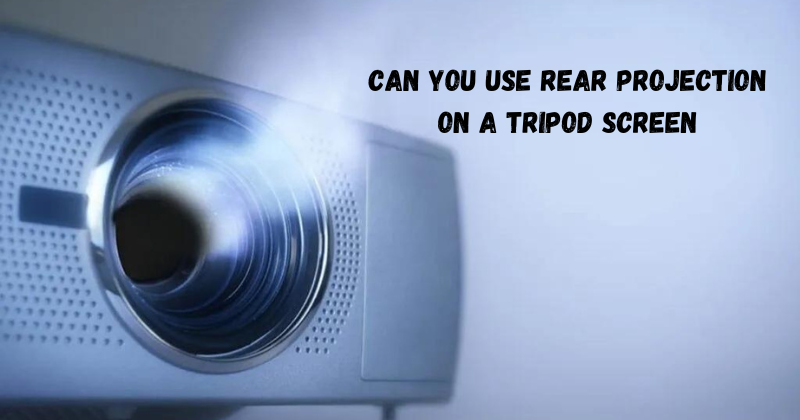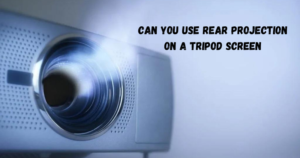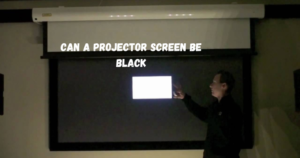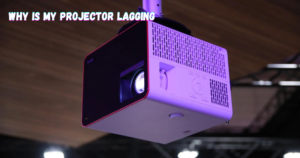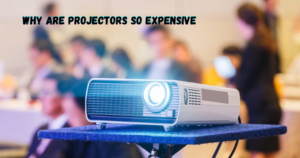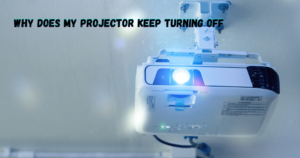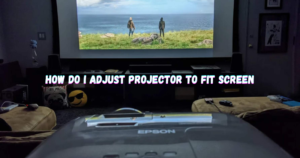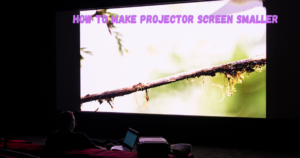Rear projection is a versatile and effective technique used in various audio-visual applications, including home theaters, presentations, and live events. It involves projecting an image or video onto a screen from behind, creating a unique viewing experience.
While rear projection is commonly associated with large screens and specialized setups, such as rear projection TVs or dedicated projection rooms, it is possible to use rear projection on a tripod screen.
A tripod screen, typically a portable and easily adjustable screen, can be a convenient solution for those seeking a flexible rear projection setup. In this discussion, we will explore the feasibility, benefits, and considerations of employing rear projection on a tripod screen, offering insights into how this combination can enhance your visual display options.
The Feasibility of Rear Projection on a Tripod Screen
Rear projection requires three elements: a projector, a screen, and an unobstructed space between them. While dedicated rear projection screens are specifically designed for this purpose, tripod screens are generally used for front projection setups. However, with the right screen material and proper setup, it is possible to achieve a rear projection image on a tripod screen.
The key to the feasibility of this combination lies in selecting the right screen material and ensuring that the projector is placed at an appropriate distance from the screen. As tripod screens are often made of white or grey fabric, they tend to be translucent, meaning light can pass through them.
In rear projection setups, this can result in a washed-out image, reducing the overall contrast and clarity of the projection. Therefore, it is crucial to choose a screen material with high opacity and light-blocking capabilities, such as specialized rear projection fabric or vinyl materials. Additionally, ensuring that the projector is placed at an appropriate distance from the screen can help minimize any potential transparency issues.
Difference Between Rear And Front Projection Screens
One of the main differences between front and rear projection screens is the material they are made of. While front projection screens reflect light to the audience, rear projection screens have a special coating that diffuses and reflects light toward the viewers. This difference in screen material allows for different viewing angles and can impact the overall quality of the projected image. To use a rear projector, you must buy a special screen explicitly made for rear projection films, presentations, or any other purpose.
Additionally, front projection setups require a dark room to achieve optimal contrast and clarity, while rear projection can often be used in well-lit environments. This makes rear projection a more versatile option for various settings and events.
Can You Use Rear Projection On A Tripod Screen?
Yes, it is possible to use rear projection on a tripod screen with the proper setup and equipment. This combination offers flexibility, portability, and cost-effectiveness, making it an attractive option for those who want to experiment with rear projection or have limited space for a dedicated setup.
While using a tripod screen for rear projection can be feasible, it may not offer the same level of image quality and performance as a dedicated rear projection screen. The tripod screen’s translucency and limited opacity can impact the brightness, contrast, and overall viewing experience. Therefore, it is essential to carefully consider the specific needs and requirements of your setup before opting for rear projection on a tripod screen.
Benefits of Using Rear Projection on a Tripod Screen
One of the primary benefits of using rear projection on a tripod screen is the ability to easily set up and adjust the viewing angle. Unlike dedicated rear projection screens, which are often fixed in place, tripod screens can be moved and positioned as needed.
This flexibility can be useful in various scenarios, such as outdoor events or temporary setups where portability and versatility are essential. Additionally, using a tripod screen can also save space and eliminate the need for additional mounting equipment, making it a convenient option for those with limited resources or space constraints. Ambient light-rejecting capabilities of specialized rear projection screen material can also enhance the overall viewing experience on a tripod screen.
Moreover, by utilizing rear projection on a tripod screen, you can achieve a more immersive viewing experience compared to traditional front projection setups. As the projector is behind the screen, there is no risk of shadows or obstructions from people walking in front of the projected image. Here are technical aspects to rear projectors, such as screen gain, viewing angles, and color reproduction.
There are also a few disadvantages:
- As mentioned earlier, choosing the right screen material is crucial for achieving a quality rear projection image on a tripod screen. This means that you may need to invest in specialized fabric or vinyl materials, which can be more expensive than standard white or grey screens.
- Rear projection setups also require more space compared to front projection. The rear projector screen needs to be placed behind the screen, and this distance can vary depending on the screen size and projector capabilities. This might not be feasible in smaller rooms or areas with limited space.
- In some cases, using rear projection on a tripod screen may result in a lower overall brightness compared to front projection. As the light is diffused and reflected towards the audience, it may not appear as bright or vivid as the front projection. This is another reason why choosing the right screen material is crucial for achieving optimal results. Ultra short throw projector is recommended for rear projection setups as it can help reduce the distance between the projector and screen, resulting in a brighter image.
Considerations When Using Rear Projection on a Tripod Screen
While rear projection on a tripod screen offers several advantages, there are also certain considerations to keep in mind when using this setup. These include:
- Screen size and material: As mentioned earlier, selecting the appropriate screen size and screen materials is crucial for a successful rear projection setup on a tripod screen. It is recommended to use specialized rear projection fabric or vinyl materials with high opacity and light-blocking capabilities. However, while a fabric screen is easier to pull off as a DIY project, an acrylic screen will require some amount of expertise.
- Projector placement: To minimize transparency issues, it is essential to place the projector at an appropriate distance from the screen. This distance can vary depending on the screen size and projector capabilities, but generally, a few feet behind the screen should suffice. Screen width and height should also be considered to avoid image distortion and loss of focus.
- Lighting: While rear projection setups can often be used in well-lit environments, it is still important to consider the lighting conditions of your setup. Too much ambient light can impact the overall brightness and clarity of the projected image.
These are some of the main considerations to keep in mind when using rear projection on a tripod screen.
How Much Space Do You Need For A Rear Projection Screen
The amount of space required for a rear projection screen can vary depending on the screen size and projector capabilities. Generally, for a standard setup, the distance between the projector and the screen should be 1-2 feet behind the screen. This distance allows for proper alignment and minimizes transparency issues caused by ambient light or other factors. Projector screens come in various sizes, and it is essential to choose one that best fits your space and requirements.
However, it is recommended to consult the manufacturer’s guidelines or seek professional advice for your specific setup to ensure optimal results. Additionally, the overall size of the setup may also depend on the amount of space available in the room or event setting. Rear projection screens typically require more space compared to front projection setups, so it is important to consider this when planning for a rear projection setup.
FAQs
Do you need a special screen for rear projection?
Yes, using a specialized screen material is crucial for achieving optimal results with rear projection. This fabric or vinyl allows for proper light diffusion and reflection, resulting in a clear and bright image.
Is rear projection better than front projection?
It depends on various factors, such as setup, lighting conditions, and personal preferences. Rear projection can offer a more immersive viewing experience and eliminate the risk of shadows or obstructions, but it may not be as bright or vivid as front projection in some cases.
Are rear projection TVs heavy?
Compared to traditional front projection setups, rear projection TVs can be heavier and bulkier due to the additional equipment needed, such as a projector and screen material. However, with advancements in technology, there are now more portable and lightweight options available for rear projection setups. It ultimately depends on the specific setup and equipment being used.
How do you film a rear projection?
To film a rear projection, you will need to place the camera behind the screen and adjust for proper lighting and focus. It is also crucial to use specialized fabric or vinyl materials that allow for proper light diffusion and reflection. Rear projectors places near the screen will likely require a short-throw lens to properly fill the screen.
Conclusion
Using rear projection on a tripod screen can be a practical and versatile choice for various settings and applications. This combination provides portability, flexibility, and ease of setup, making it suitable for presentations, home theaters, events, and more. While some considerations like screen quality, projector placement, and ambient light control should be addressed, the benefits of this approach, including a clean, unobstructed display and the elimination of shadow interference, make it an attractive option.
Whether you’re a professional presenter or a home entertainment enthusiast, exploring rear projection on a tripod screen opens up new possibilities for creating impressive visual experiences in a user-friendly and adaptable manner. So, next time you’re planning for a presentation or movie night, consider the benefits of using rear projection on a tripod screen and see the difference it makes in your display quality! So why wait? Start exploring rear projection on a tripod screen today and take your visual displays to the next level.
